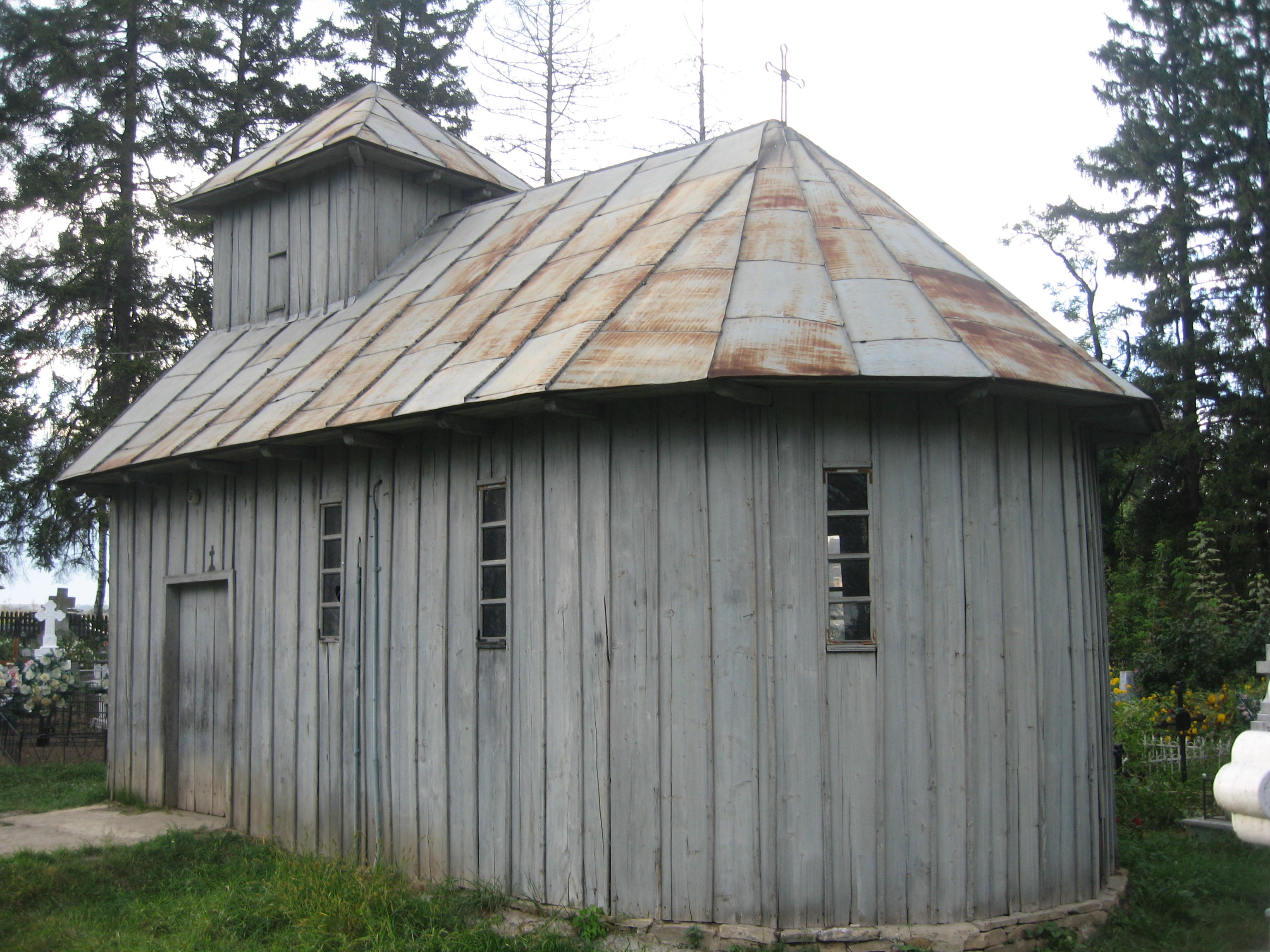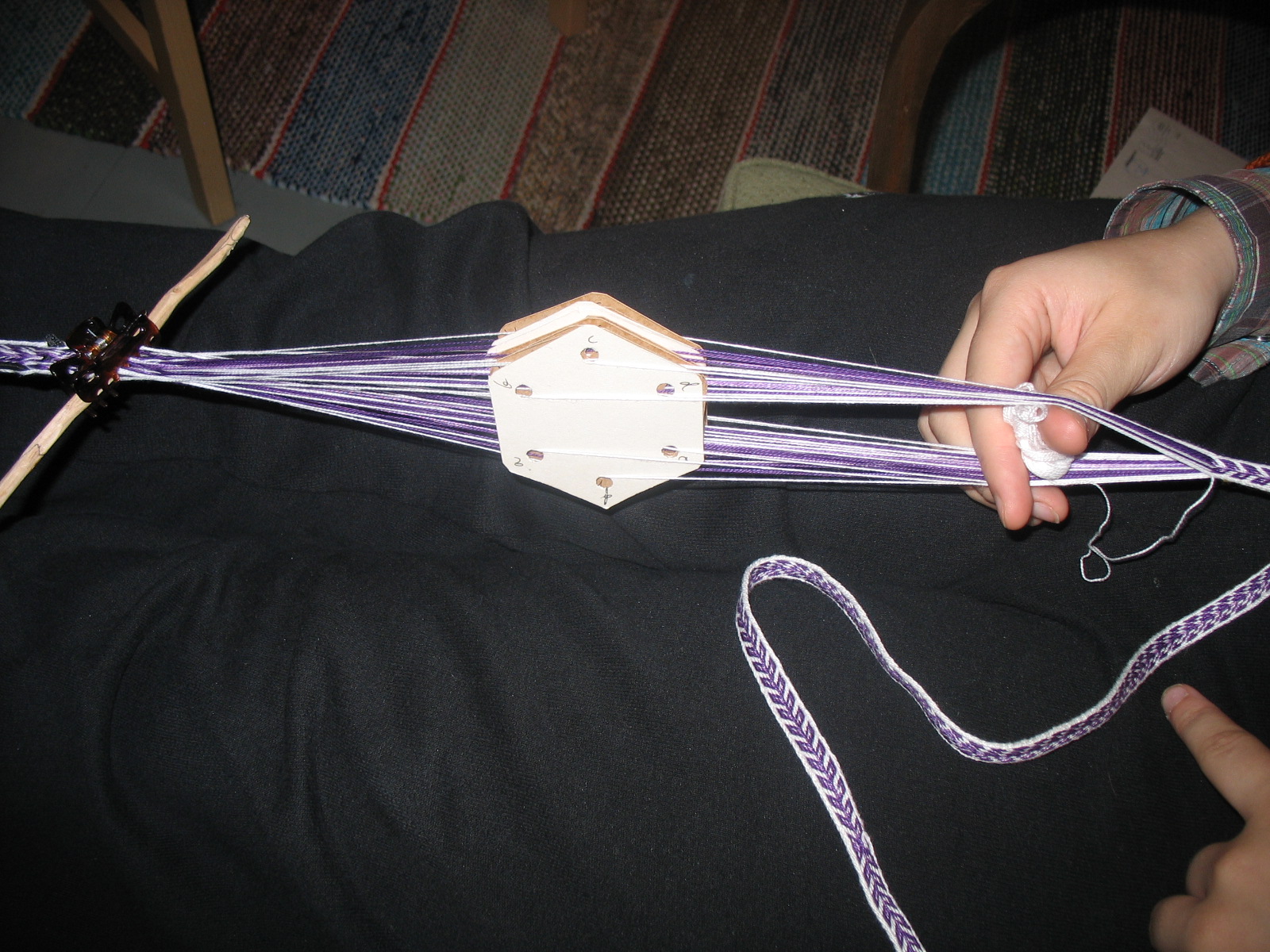|
Beater (weaving)
A beater or batten, is a weaving tool designed to push the weft yarn securely into place. In small hand weaving such as Inkle weaving and tablet weaving the beater may be combined with the shuttle into a single tool. In rigid heddle looms the beater is combined with the heddles. Beaters appear both in a hand-held form, and as an integral part of a loom. Hand beaters must have enough mass to force the weaving into place, so they come in a variety of weights and sizes. Some may have lead inserts to provide additional heft for a smaller beater, and some are made entirely from metal. Loom beaters typically take the form of a bar mounted across the loom. The actual beating is done by a metal insert known as a reed, which contains a number of slots, known as dents, which the warp threads pass through. This is the more common form, as floor looms and mechanized looms both use a beater with a reed. File:Salish Baton.JPG, Coast Salish sword beater, North American west coast File:Gr ... [...More Info...] [...Related Items...] OR: [Wikipedia] [Google] [Baidu] |
Heddle
A heddle or heald is an integral part of a loom. Each thread in the warp passes through a heddle,"Weaving." ''The Encyclopædia Britannica''. 11th ed. 1911. which is used to separate the warp threads for the passage of the weft."Heddle." ''The Oxford English Dictionary''. 2nd ed. 1989. The typical heddle is made of cord or wire and is suspended on a shaft of a loom. Each heddle has an eye in the center where the warp is threaded through. As there is one heddle for each thread of the warp, there can be near a thousand heddles used for fine or wide warps. A handwoven tea-towel will generally have between 300 and 400 warp threads and thus use that many heddles. In weaving, the warp threads are moved up or down by the shaft. This is achieved because each thread of the warp goes through a heddle on a shaft. When the shaft is raised the heddles are too, and thus the warp threads threaded through the heddles are raised. Heddles can be either equally or unequally distributed on the ... [...More Info...] [...Related Items...] OR: [Wikipedia] [Google] [Baidu] |
Reed (weaving)
A reed is part of a weaving loom, and resembles a comb or a frame with many vertical slits. It is used to separate and space the warp threads, to guide the shuttle's motion across the loom, and to push the weft threads into place."Reed." ''The Oxford English Dictionary''. 2nd ed. 1989.1911 Encyclopædia Britannica In most floor looms with, the reed is securely held by the beater. Floor looms and mechanized looms both use a beater with a reed, whereas Inkle weaving and tablet weaving do not use reeds. History Modern reeds are made by placing flattened strips of wire (made of carbon or stainless steel) between two half round ribs of wood, and binding the whole together with tarred string. Historically, reeds were made of reed or split cane. The split cane was then bound between ribs of wood in the same manner as wire is now. In 1738, John Kay replaced split cane with flattened iron or brass wire, and the change was quickly adopted. To make a reed, wire is flattened to ... [...More Info...] [...Related Items...] OR: [Wikipedia] [Google] [Baidu] |
Coast Salish
The Coast Salish peoples are a group of ethnically and linguistically related Indigenous peoples of the Pacific Northwest Coast, living in the Canadian province of British Columbia and the U.S. states of Washington and Oregon. They speak one of the Coast Salish languages. The Coast Salish are a large, loose grouping of many nations with numerous distinct cultures and languages. Territory claimed by Coast Salish peoples span from the northern limit of the Salish Sea on the inside of Vancouver Island and covers most of southern Vancouver Island, all of the Lower Mainland and most of Puget Sound and the Olympic Peninsula (except for territories of the Chemakum people). Their traditional territories coincide with modern major metropolitan areas, namely Victoria, Vancouver, and Seattle. The Tillamook or Nehalem around Tillamook, Oregon are the southernmost of the Coast Salish peoples. Coast Salish cultures differ considerably from those of their northern neighbours. Th ... [...More Info...] [...Related Items...] OR: [Wikipedia] [Google] [Baidu] |
Warp (weaving)
In the manufacture of cloth, warp and weft are the two basic components in weaving to transform thread and yarn into textile fabrics. The vertical ''warp'' yarns are held stationary in tension on a loom (frame) while the horizontal ''weft'' (also called the ''woof'') is drawn through (inserted over and under) the warp thread. In the terminology of weaving, each warp thread is called a ''warp end''; a ''pick'' is a single weft thread that crosses the warp thread (synonymous terms are ''fill yarn'' and ''filling yarn'').Burnham (1980), pp. 170, 179Barber (1991), p. 79. In the 18th century, the Industrial Revolution facilitated the industrialisation of the production of textile fabrics with the "picking stick" and the " flying shuttle", the latter of which was invented by John Kay, in 1733. The mechanised power loom was patented by Edmund Cartwright in 1785, which allowed sixty picks per minute. Etymology The word ''weft'' derives from the Old English word , to weave. ''Wa ... [...More Info...] [...Related Items...] OR: [Wikipedia] [Google] [Baidu] |
Reed (weaving)
A reed is part of a weaving loom, and resembles a comb or a frame with many vertical slits. It is used to separate and space the warp threads, to guide the shuttle's motion across the loom, and to push the weft threads into place."Reed." ''The Oxford English Dictionary''. 2nd ed. 1989.1911 Encyclopædia Britannica In most floor looms with, the reed is securely held by the beater. Floor looms and mechanized looms both use a beater with a reed, whereas Inkle weaving and tablet weaving do not use reeds. History Modern reeds are made by placing flattened strips of wire (made of carbon or stainless steel) between two half round ribs of wood, and binding the whole together with tarred string. Historically, reeds were made of reed or split cane. The split cane was then bound between ribs of wood in the same manner as wire is now. In 1738, John Kay replaced split cane with flattened iron or brass wire, and the change was quickly adopted. To make a reed, wire is flattened to ... [...More Info...] [...Related Items...] OR: [Wikipedia] [Google] [Baidu] |
Lead
Lead () is a chemical element; it has Chemical symbol, symbol Pb (from Latin ) and atomic number 82. It is a Heavy metal (elements), heavy metal that is density, denser than most common materials. Lead is Mohs scale, soft and Ductility, malleable, and also has a relatively low melting point. When freshly cut, lead is a shiny gray with a hint of blue. It tarnishes to a dull gray color when exposed to air. Lead has the highest atomic number of any stable nuclide, stable element and three of its isotopes are endpoints of major nuclear decay chains of heavier elements. Lead is a relatively unreactive post-transition metal. Its weak metallic character is illustrated by its Amphoterism, amphoteric nature; lead and lead oxides react with acids and base (chemistry), bases, and it tends to form covalent bonds. Lead compounds, Compounds of lead are usually found in the +2 oxidation state rather than the +4 state common with lighter members of the carbon group. Exceptions are mostly limited ... [...More Info...] [...Related Items...] OR: [Wikipedia] [Google] [Baidu] |
Loom
A loom is a device used to weaving, weave cloth and tapestry. The basic purpose of any loom is to hold the Warp (weaving), warp threads under tension (mechanics), tension to facilitate the interweaving of the weft threads. The precise shape of the loom and its mechanics may vary, but the basic function is the same. Etymology and usage The word "loom" derives from the Old English ''geloma'', formed from ''ge-'' (perfective prefix) and ''loma'', a root of unknown origin; the whole word ''geloma'' meant a utensil, tool, or machine of any kind. In 1404 "lome" was used to mean a machine to enable weaving thread into cloth. By 1838 "loom" had gained the additional meaning of a machine for interlacing thread. Components and actions Basic structure File:Simple_treadle_floorloom,_line_drawing.png, upright=1.5, left, A simple treadle floor loom. Mouse over components for pop-up links. The warp runs horizontally. On the left the warp beam, held from turning by with a weighted trough t ... [...More Info...] [...Related Items...] OR: [Wikipedia] [Google] [Baidu] |
Batten
A batten is most commonly a strip of solid material, historically wood but can also be of plastic, metal, or fiberglass. Battens are variously used in construction, sailing, and other fields. In the lighting industry, battens refer to linear light fittings. In the steel industry, battens used as furring may also be referred to as "top hats", in reference to the profile of the metal. Roofing ''Roofing battens'' or ''battening'', also called ''roofing lath'', are used to provide the fixing point for roofing materials such as shingles or tiles. The spacing of the battens on the trusses or rafters depend on the type of roofing material and are applied horizontally like purlins. Battens are also used in metal roofing to secure the sheets called a ''batten-seam roof'' and are covered with a ''batten roll joint''. Some roofs may use a grid of battens in both directions, known as a ''counter-batten system'', which improves ventilation. Roofing battens are most commonly made of ... [...More Info...] [...Related Items...] OR: [Wikipedia] [Google] [Baidu] |
Shuttle (weaving)
A shuttle is a tool designed to neatly and compactly store a holder that carries the thread of the weft yarn while weaving with a loom. Shuttles are thrown or passed back and forth through the shed A shed is typically a simple, single-storey (though some sheds may have two or more stories and or a loft) roofed structure, often used for storage, for hobby, hobbies, or as a workshop, and typically serving as outbuilding, such as in a bac ..., between the yarn threads of the warp in order to weave in the weft. The simplest shuttles, known as "stick shuttles", are made from a flat, narrow piece of wood with notches on the ends to hold the weft yarn. More complicated shuttles incorporate bobbins or pirns. In the United States, shuttles are often made of wood from the flowering dogwood, because it is hard, resists splintering, and can be polished to a very smooth finish. In the United Kingdom shuttles were usually made of boxwood, cornel, or persimmon. Gallery File:Lauta ... [...More Info...] [...Related Items...] OR: [Wikipedia] [Google] [Baidu] |
Tablet Weaving
Tablet weaving (often card weaving in the United States) is a weaving technique where ''tablets'' or ''cards'' are used to create the Shed (weaving), shed through which the weft is passed. As the materials and tools are relatively cheap and easy to obtain, tablet weaving is popular with hobbyist weavers. Most tablet weavers produce narrow work such as belts, straps, or garment trims. History Tablet weaving dates back at least to the 8th century BCE in early Iron Age Europe where it is found in areas employing the warp-weighted loom. Historically the technique served several purposes: to create starting and/or selvedge bands for larger textiles such as those produced on the warp-weighted loom; to weave decorative bands onto existing textiles;Ræder Knudsen, L. 1998. "An Iron Age Cloak with Tablet-woven Borders: a New Interpretation of the Method of Production." In ''Textiles in European Archaeology: Report from the 6th NESAT Symposium,'' pp. 79-84. and to create freestand ... [...More Info...] [...Related Items...] OR: [Wikipedia] [Google] [Baidu] |







